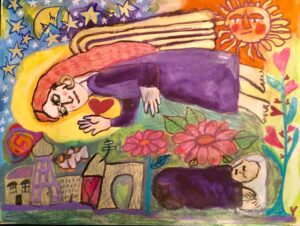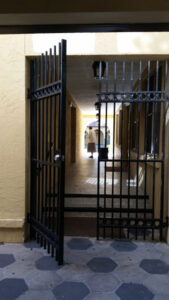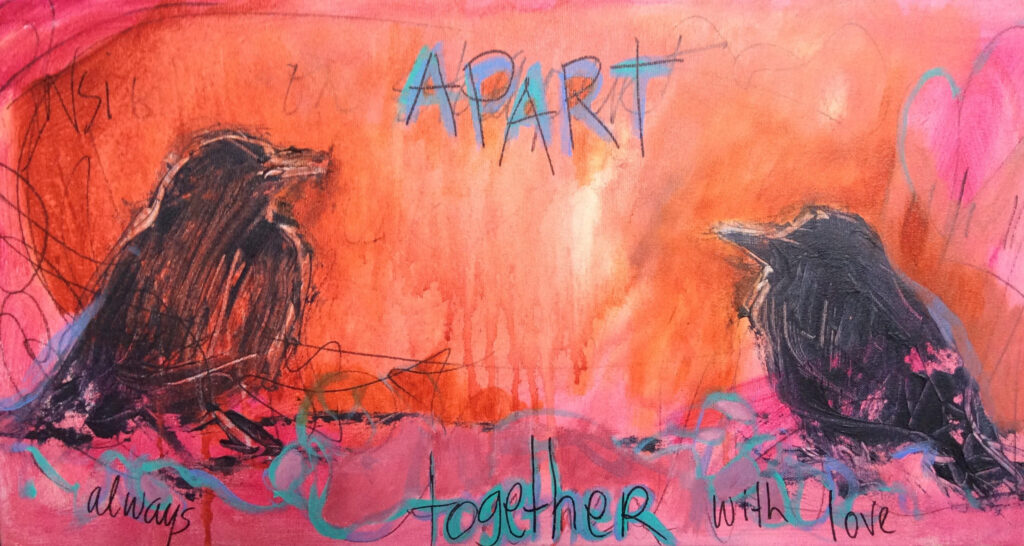Contemplative Times, Issue # 8
The Newsletter of Meditation Chapel
The Meditation Chapel Vision
Meditation Chapel nurtures unity and world peace through the sharing of divine stillness and sacred listening. We support groups of all faith traditions in offering and sharing the contemplative experience through the sacramental use of technology.
The self-surrender that happens during meditation is a death of the ego…an exercise in letting go of the self and all its possessions, attachments, thoughts, memories, and beliefs…The finish line where death occurs is but another starting line, the frontier bordering a new form of existence. This awareness already can afford us a sense of peace (and perhaps a powerful curiosity).
~ John Richard Sack

Photo by Laura Waters
Surrender. The word evokes a multitude of images, an assortment of reasons to resist it, and sweet memories of all that has already been surrendered by us and for us. As contemplatives, our practices train us to surrender daily, to hand over to Spirit all that we are, all that we desire, all that we love and think and feel. The training ground is ordinary life, while surrendering to the Divine in a present-moment-awareness is anything but ordinary. It is Grace.
Throughout life, surrendering is a process. Learning to surrender outcomes and expectations becomes daily routine. Realizing that our way is not always the way of the Divine is a sign of maturity. This does not happen overnight for us, but it does happen. We learn to surrender to Divine Will in an election cycle, in a pandemic, for a loved one’s health, for a new career, for our child’s life-path, for hope for humanity. We do our part, of course, and act when and where possible, but if we are who we claim to be – a vessel for Spirit – then we surrender and trust, rinse, and repeat, knowing that all is well and shall be well, like Julian of Norwich.
And yet, we resist surrender until the Holy breaks us open, and we know that surrender is the best choice. It is the wisdom of surrender that I find most mysterious, for it is pure humility. Two of the most memorable events of surrender in my life happened when a doctor told me I had cancer, and my initial encounter with the Holy Spirit in an addiction recovery center. While the road to those moments of capitulation were formed by suffering, in both instances, surrender was the immediate and natural response. Surely we all have had wondrous experiences of surrender that are worth sharing, as they often serve as seeds and light for others.
We can learn surrender from Earthly creatures – how the grass and the flowers and the trees and the animals surrender to the will of rain, light, seasons, and wind. We see daily examples in our own lives as well – trusting the next step is guided by Love, laying our heads down to sleep at night, and kneeling at the altar of meditation and prayer.
The beautiful truth is that we are walking this path of surrender and trust TOGETHER, in our Meditation Chapel community. We help each other walk deeper into authenticity in our relationships with each other, with ourselves, and with Source.
Members of our community have contributed to this newsletter’s theme with a variety of heartening offerings. Shaun Macloughlin and Robert Lalor share their stories of surrender and trust. Roger Sessions reveals an exciting development in Meditation Chapel’s direction. Additionally, we have artistic contributions by Renate Rothwell, Nancy Ann Edwards, Janice Andrews, Karen Rushen O’Brien, and Lawrence Gabriel Muller.
As you read through this issue of Contemplative Times, I invite you to consider these questions: What can I surrender today? How can I trust more deeply right now? This year’s holidays may require us to consider letting go of long-held traditions for the sake of everyone’s health. Remember that letting go is a sacred act.
As Marianne Williamson said, “The moment of surrender is not when life is over, it’s when it begins.”
Thank you for being here.

Photo by Renate Rothwell
“Surrender your own poverty and acknowledge your nothingness to the Lord. Whether you understand it or not, God loves you, is present in you, lives in you, dwells in you, calls you, saves you and offers you an understanding and compassion which are like nothing you have ever found in a book or heard in a sermon.”
― Thomas Merton
On Surrender and Trust by Shaun MacLoughlin
When Laura asked me to write about Surrender and Trust, I thought of two French poets. As a schoolboy some sixty years ago and on holiday in France I met Marie Louise Van Veen, an eccentric and inspiring ballet teacher, who used to dance the Mass. Pointing to heaven she described Charles Peguy as a “pillar of fire”, while Paul Claudel she said, flinging out her arms, “embraced to whole world”
Claudel as well as being a prolific writer was French ambassador to both China and the U.S.A. He wrote of Saint Joseph, who so quietly surrendered to God. I quote:
Saint Joseph was at once a workman and a gentleman. He was cheerful and silent, with a big noble nose, muscular arms and hands. How patient he must have been, like the sun beginning the same round every morning without weariness. I see him in his workshop on a sunny morning. I hear the saw and a child coming to look for him, calling “Joseph, Joseph.” Children must have loved him. Next I see him coming back from Jerusalem with his Bride so young and gentle.
Joseph is the patron of the hidden life. Scripture does not report a single word of his. it is the silence who is father to the word. He is the patron of bachelors and of fathers, of laymen and of contemplatives, of priests and of business men. His last days of failing health must have been touching between Jesus and Mary, when he could no longer work! I see the coachman of one of those fine ladies, who went to the waters of Tiberias, drawing up at the sick carpenter’s to get the carriage mended. Jesus Himself takes it over and takes the tools from his hands. Here are only three poor folk loving one another, and they are going to change the face of the world.
Charley Peguy was of peasant stock. He was an atheist who slowly returned to the Faith of his fathers, a few years before he was killed in the First World War. He wrote of hope which is a kind of surrender and trust:
What astonishes me most, says God, is hope.
Faith doesn’t surprise me.
I am so resplendent in my creation. . . .
That in order really not to see me these poor people would have to be blind.
Charity says God, that doesn’t surprise me.
These poor creatures are so miserable that unless they had a heart of stone, how could they not have love for one another?
How could they not take the bread from their own mouth, their daily bread, in order to give it to the unhappy children who pass by?
And my son had such love for them. . . .
But hope, says God, that is something that surprises me.
That these poor children see how things are going and believe that tomorrow things will go better.
That is surprising and it’s by far the greatest marvel of our grace.
And I’m surprised by it myself.
And my grace must indeed be an incredible force.

While You Were Asleep by Karen Rushen O’Brien
Things You May Notice Growing Old
by Nancy Edwards
One of the things you may notice growing old is your skin. It’s large and shapely surface sagging, becoming rather thin—perhaps God’s holy way to allow more light within, a humble shedding over time.
And then the forgetting—oh such bliss! Fretful pride struggling to remember inhibits pleasure in moments such as this! How good to freely fall, let go wanting to recall.
When getting out of bed, disjointed and in pain, unable to move ahead and reaching for a cane, you may find yourself tethered, a gradual slowing down and stay inside the house all day dressed in your night gown.
Growing old, a process, a movement further in. As society contracts, your life expands within. Your eyes begin to hurt, more sensitive to light, so you close them in the day as well as in the night. Your visions and your memories, depending where you’ve been, will either make you frown or serenely smile and grin.
There may come a time yet still when thoughts turn dark and then you will…find yourself alone, no visits from your former friends or family from your home. These are days that no one wants, no one at any age. They are part of lives lived long, times you’ll feel estranged, until you feel your next breath rising, coming from its source, understanding love eternal to be the greater force.
When all there is is breathing keeping you alive, you’ll feel the Presence of its Giver steadfast by your side.
AN OPEN DOOR by Robert Lalor
1 Cor 13:7- [Love] always protects, always trusts, always hopes, always perseveres. Love never fails.
During my first six decades of life, I had glimpses of God, but they didn’t seem to penetrate or change my heart. Often, in frustration, I would say to God “Come on then!!! If You love me, as You say that You do, sort out my life already!!! Haven’t I been patient and persevered enough???!!!”

Photo by Laura Waters
Then in Easter 2015, by God’s grace and at a particularly challenging time in my life, I was miraculously guided to a week of contemplation, having absolutely no concept of meditation/contemplation. On the very first night, I got the answer to the most important question of my life; an answer so profound that I lacked the wisdom even to form the question. God revealed to me that my security was in Him/Her and in Him/Her alone. On the second night, I was gifted the answer to the second most important question. I was given the Parable of the Prodigal Son in a most profound way. The father did not pursue the son into the pig pen. Rather he waited for the son to come to his senses. Talk about conversion!!! God has such a wonderful sense of humour – the venue for the retreat was the Emmaus Center in London.
I realised that until this moment I had not even begun to surrender. My trust and my hope was in myself (or people whom I admired), not in God. It took sixty years of hitting my head against a wall to realise (a) that it was not the fault of the wall, and (b) that there was an open door right built into the wall, if only I would open my eyes and heart.
Today, I spent less time hitting my head against walls and more time bowing it in prayer. I now know that conversion begins with conversation, not dictation. I am having the best year of my life with the certain trust that next year will be even better. All I need do is to surrender and place my hope where it belongs.
|
WELCOME TO OUR NEW GROUPS AND FACILITATORS! What: Welcoming Prayer Group What: Centering Prayer as the 11th Step (in English) What: A Radiance of Love Meditation Group What: Coffee Time with the Women Mystics What: Rainbow Contemplatives Group We welcome Rev. Sandra Lovern as our 100th facilitator, as she now facilitates the Church of England Service on Sunday mornings. |

by Janice Andrews
NATARAJA’S SMILE by Lawrence Gabriel Muller
Many rooms, doors upon doors, stage of dance and dreams,
Enter a prince, or a homeless wanderer, both roaming about
Across fields of glory, or an unkind society’s marked disdain —
Skies are blue except when they are not, thoughts are yet
Emptiness unto a new fullness made of a humility birthing.
A mouse skirts across night kitchen floor, passes out of sight;
Would you only please stop by awhile to ease the loneliness —
Ah, like us too, you sense the implied danger in our meeting.
Were Jesus and Buddha to meet under the glow of Liberty’s light,
What might they share, and would we truly want to listen anew?
Take care of each other and this world of wonder: begin today.
Being grateful with every breath, and let not our fears divide us.
Look to the land, and the water; air, earth, fire. Thus, be all sacred.
Nataraja third-eye open, Marley love-anthem, beating hearts unite.

Photo by Lawrence Gabriel Muller
“TRIPPING OVER JOY
What is the difference
Between your experience of Existence
And that of a saint?
The saint knows
That the spiritual path
Is a sublime chess game with God
And that the Beloved
Has just made such a Fantastic Move
That the saint is now continually
Tripping over Joy
And bursting out in Laughter
And saying, “I Surrender!”
Whereas, my dear,
I am afraid you still think
You have a thousand serious moves.”
― Hafez, I Heard God Laughing: Poems of Hope and Joy
| NEWS FROM THE MEDITATION CHAPEL STEERING COMMITTEE |
Dear Meditators,
I would like to share some news with you about the future of Meditation Chapel. The Steering Committee has decided to move forward with making Meditation Chapel a formal nonprofit corporation.
What does this mean to you? Probably, not much. Everything will operate exactly as it does today. Our Vision Statement will remain unchanged:
Meditation Chapel nurtures unity and world peace through the sharing of divine stillness and sacred listening. We support groups of all faith traditions in offering and sharing the contemplative experience through the sacramental use of technology.
But it does mean a lot to our future. It gives Meditation Chapel the legal and financial structure it needs to grow and support the interfaith contemplative community for decades to come. It also means that if you are able to contribute to Meditation Chapel financially (and this has never been, and never will be a requirement), that now you will be able to declare that contribution as a charitable contribution.
Somebody recently asked me if this means that Meditation Chapel is going to become a church. I can assure you there has been no discussion of this within the Steering Committee. We welcome churches that want to offer a contemplative experience, as we welcome all contemplative groups. But Meditation Chapel will always be a community that welcomes all contemplatives, regardless of faith or non-faith. We believe that all stillness is holy, and it makes no difference whose banner is on the door.
We are in the early phases of this. We hope to complete the legal process in early 2021. If you normally make a financial contribution to Meditation Chapel, we are asking you to hold off until we have completed this transition.
Peace and love to you all!
Roger Sessions (for the Steering Committee)

Copyright © 2020 Online Meditation Chapel, All rights reserved.
